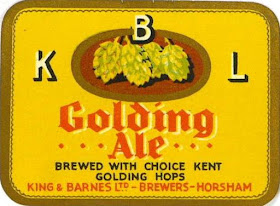I'd noticed when writing recipes that fresh hops - ones from the most recent season - virtually disappeared aafter 1916. looking at the table, the reason is obvious: hop production had collapsed. The reason? The government ordered hop farmer to grub up some of their bines and grow food instead. Almost overnight the area planted with hops was halved.
I can see the logic. Fewer hops were going to be needed, as the emount of beer being produced had declined. And some of the hop growing areas - Kent, for example - are very fertile.
Bit of a double whammy, as hop imports dried up at exactly the same time. I was slightly surprised to se Amrican hops from the 1914 and 1915 seasons quite regularly in brewing records. But not later seasons. In 1918 and 1919 really ancient American hops appear. Ones as old as 1910. It looks to me like brewers were using up their emergency stocks.
That also explains how in 1917, 1918 and 1919 more hops were used than were available. The number s don't take into account old stocks lying around in breweries.
Aware that there was a shortage of hops, the government stepped in and bought the whole hop crop and distributed it to brewers. The system continued even after war's end, the aim being to rebuild the hop growing industry. To help this, no foreign hops could be imported until the whole UK crop had been sold.
Even with this help, the acreage under hops never got back to its 1914 level.
| Table 15- Total quantity of Hops available for consumption in the United Kingdom, and the averages for ten years. | ||||||
| Year. | Area. Acres. | Estimated Production Cwts. | Imports less Exports. Cwts. | Available for Consumption. Cwts. | Consumption (See Table 2). | % imports |
| 1905 | 48,967 | 695,943 | 83,278 | 779,221 | 656,792 | 12.68% |
| 1908 | 38,916 | 470,761 | 257,792 | 728,463 | 562,247 | 45.85% |
| 1909 | 32,539 | 214,484 | 118,568 | 333,052 | 548,445 | 21.62% |
| 1910 | 32,886 | 302,675 | 163,105 | 465,780 | 551,248 | 29.59% |
| 1911 | 33,056 | 328,023 | 102,167 | 430,190 | 574,260 | 17.79% |
| 1912 | 34,829 | 373,438 | 223,566 | 596,994 | 549,507 | 40.68% |
| 1913 | 35,676 | 265,641 | 234,837 | 490,478 | 561,708 | 41.81% |
| 1914 | 36,661 | 507,258 | 73,778 | 581,031 | 559,423 | 13.19% |
| average 1905-14 | 38,518 | 376,803 | 166,008 | 542,802 | 560,549 | 29.62% |
| 1915 | 34,744 | 254,101 | 191,059 | 495,160 | 467,142 | 40.90% |
| 1916 | 31,352 | 307,856 | 135,385 | 443,241 | 450,257 | 30.07% |
| 1917 | 16,626 | 226,763 | 4,446 | 230,209 | 329,334 | 1.35% |
| 1918 | 15,626 | 138,491 | 6,664 | 145,155 | 263,392 | 2.53% |
| 1919 | 16,762 | 187,795 | 151,485 | 339,280 | 400,000 | 37.87% |
| 1920 | 21,685 | 258,042 | 452,124 | 710,166 | 450,000 | 100.47% |
| 1921 | 25,186 | 236,172 | 214,364 | 450,536 | 425,000 | 50.44% |
| Source: | ||||||
| 1922 Brewers' Almanack, page 119. | ||||||

No comments:
Post a Comment